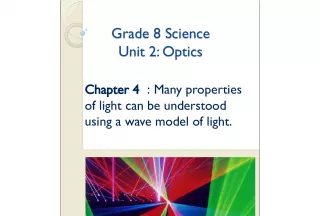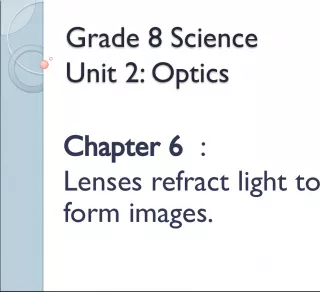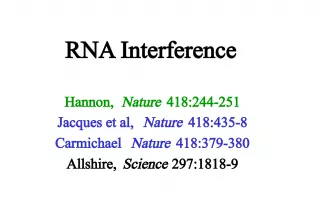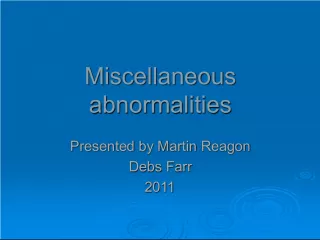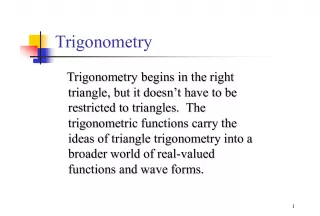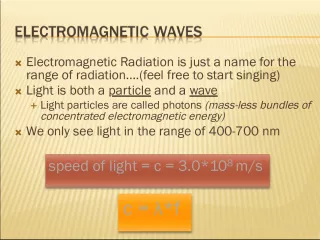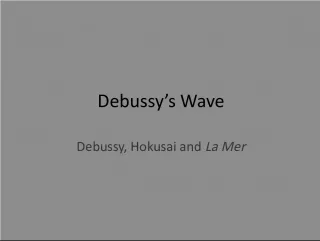Wave Optics and Interference
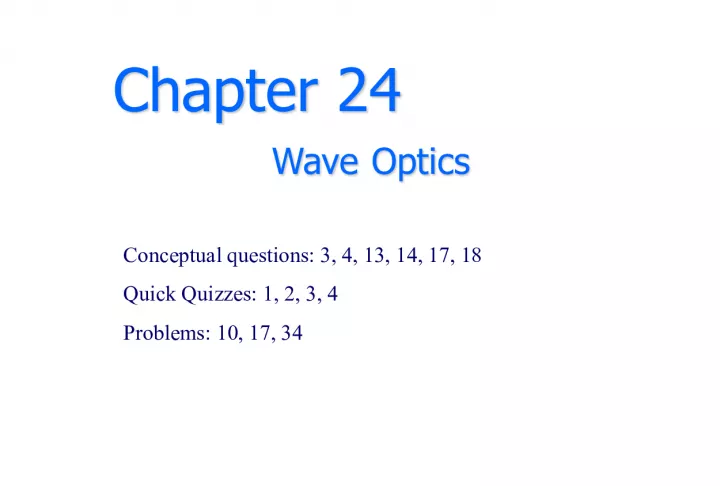

Chapter 24 covers conceptual questions (3, 4, 13, 14, 17, 18), quick quizzes (1, 2, 3, 4), and problems (10, 17, 34) on wave optics. This includes interference where light waves interfere like mechanical waves. Coherence and identical wavelengths are two conditions required for interference.
- Uploaded on | 0 Views
-
 emiliemercier
emiliemercier
About Wave Optics and Interference
PowerPoint presentation about 'Wave Optics and Interference'. This presentation describes the topic on Chapter 24 covers conceptual questions (3, 4, 13, 14, 17, 18), quick quizzes (1, 2, 3, 4), and problems (10, 17, 34) on wave optics. This includes interference where light waves interfere like mechanical waves. Coherence and identical wavelengths are two conditions required for interference.. The key topics included in this slideshow are . Download this presentation absolutely free.
Presentation Transcript
1. Chapter 24 Chapter 24 Wave Optics Wave Optics Conceptual questions: 3, 4, 13, 14, 17, 18 Quick Quizzes: 1, 2, 3, 4 Problems: 10, 17, 34
2. Interference Interference Light waves interfere with each other much like mechanical waves do Light waves interfere with each other much like mechanical waves do Two conditions which must be met Two conditions which must be met 1. The sources must be coherent . They must maintain a constant phase with respect to each other 1. The sources must be coherent . They must maintain a constant phase with respect to each other 2. The waves must have identical wavelengths 2. The waves must have identical wavelengths
3. Producing Coherent Sources Producing Coherent Sources Old method: Old method: Light from a monochromatic source is allowed to pass through a narrow slit Light from a monochromatic source is allowed to pass through a narrow slit The light from the single slit is allowed to fall on a screen containing two narrow slits The light from the single slit is allowed to fall on a screen containing two narrow slits The first slit is needed to insure the light comes from a tiny region of the source which is coherent The first slit is needed to insure the light comes from a tiny region of the source which is coherent New method: use a laser New method: use a laser
4. Young’s Double Slit Experiment Young’s Double Slit Experiment The narrow slits, S 1 and S 2 act as sources of waves The narrow slits, S 1 and S 2 act as sources of waves The waves emerging from the slits originate from the same wave front and therefore are always in phase The waves emerging from the slits originate from the same wave front and therefore are always in phase
5. Interference Patterns Interference Patterns Constructive interference occurs at the center point Constructive interference occurs at the center point The two waves travel the same distance and they arrive in phase The two waves travel the same distance and they arrive in phase
6. Interference Patterns, 2 Interference Patterns, 2 The upper wave travels one wavelength farther The upper wave travels one wavelength farther Therefore, the waves arrive in phase Therefore, the waves arrive in phase A bright fringe occurs A bright fringe occurs
7. Interference Patterns, 3 Interference Patterns, 3 The upper wave travels one-half of a wavelength farther than the lower wave The upper wave travels one-half of a wavelength farther than the lower wave The trough of the bottom wave overlaps the crest of the upper wave The trough of the bottom wave overlaps the crest of the upper wave This is destructive interference This is destructive interference A dark fringe occurs A dark fringe occurs
8. Interference Equations Interference Equations The path difference, δ, is found from the tan triangle The path difference, δ, is found from the tan triangle δ = r 2 – r 1 = d sin θ δ = r 2 – r 1 = d sin θ This assumes the paths are parallel This assumes the paths are parallel
9. Interference Equations, 2 Interference Equations, 2 For a bright fringe, produced by constructive interference, the path difference must be For a bright fringe, produced by constructive interference, the path difference must be δ = m λ δ = m λ m = 0, ±1, ±2, … m = 0, ±1, ±2, … δ = d sin θ bright = m λ δ = d sin θ bright = m λ m is called the order number m is called the order number When m = 0, it is the zeroth order maximum When m = 0, it is the zeroth order maximum When m = ±1, it is called the first order maximum When m = ±1, it is called the first order maximum
10. Interference Equations, 3 Interference Equations, 3 When destructive interference occurs, a dark fringe is observed When destructive interference occurs, a dark fringe is observed This needs a path difference of an odd half wavelength; δ = (m + ½) λ This needs a path difference of an odd half wavelength; δ = (m + ½) λ δ = d sin θ dark = (m + ½) λ δ = d sin θ dark = (m + ½) λ m = 0, ±1, ±2, … m = 0, ±1, ±2, …
11. Interference Equations, 4 Interference Equations, 4 The positions of the fringes can be measured vertically from the zeroth order maximum The positions of the fringes can be measured vertically from the zeroth order maximum y = L tan θ ~ L sin θ y = L tan θ ~ L sin θ Approximation Approximation θ is small and therefore tan θ ~ sin θ θ is small and therefore tan θ ~ sin θ For bright fringes For bright fringes For dark fringes For dark fringes
12. Quick quiz 24-1 Quick quiz 24-1 In a two slit interference pattern projected on a screen the fringes are equally spaced on the screen In a two slit interference pattern projected on a screen the fringes are equally spaced on the screen A. everywhere A. everywhere B. only for large angles B. only for large angles C. only for small angles C. only for small angles
13. Problem 24.10 Problem 24.10 A pair of slits, separated by 0.150 mm, is illuminated by light having a wavelength of λ = 643 nm. An interference pattern is observed on a screen 140 cm from the slits. Consider a point on the screen located at y = 1.80 cm from the central maximum of this pattern. (a) What is the path difference δ for the two slits at the location y ? (b) Express this path difference in terms of the wavelength. (c) Will the interference correspond to a maximum, a minimum, or an intermediate condition?
14. Phase Changes Due To Reflection Phase Changes Due To Reflection An electromagnetic wave undergoes a phase change of 180° upon reflection from a medium of higher index of refraction than the one in which it was traveling An electromagnetic wave undergoes a phase change of 180° upon reflection from a medium of higher index of refraction than the one in which it was traveling Analogous to a reflected pulse on a string Analogous to a reflected pulse on a string
15. Phase Changes Due To Reflection, cont Phase Changes Due To Reflection, cont There is no phase change when the wave is reflected from a boundary leading to a medium of lower index of refraction There is no phase change when the wave is reflected from a boundary leading to a medium of lower index of refraction Analogous to a pulse in a string reflecting from a free support Analogous to a pulse in a string reflecting from a free support
16. Interference in Thin Films Interference in Thin Films Rules to remember Rules to remember 1. An electromagnetic wave traveling from a medium of index of refraction n 1 toward a medium of index of refraction n 2 undergoes a 180° phase change on reflection when n 2 > n 1 1. An electromagnetic wave traveling from a medium of index of refraction n 1 toward a medium of index of refraction n 2 undergoes a 180° phase change on reflection when n 2 > n 1 2. There is no phase change in the reflected wave if n 2 < n 1 2. There is no phase change in the reflected wave if n 2 < n 1 3. The wavelength of light λ n in a medium with index of refraction n is λ n = λ/n where λ is the wavelength of light in vacuum 3. The wavelength of light λ n in a medium with index of refraction n is λ n = λ/n where λ is the wavelength of light in vacuum
17. Interference in Thin Films, 2 Interference in Thin Films, 2 Ray 1 undergoes a phase change of 180° with respect to the incident ray Ray 1 undergoes a phase change of 180° with respect to the incident ray Ray 2, which is reflected from the lower surface, undergoes no phase change with respect to the incident wave Ray 2, which is reflected from the lower surface, undergoes no phase change with respect to the incident wave Ray 2 also travels an additional distance of 2t before the waves recombine Ray 2 also travels an additional distance of 2t before the waves recombine
18. Interference in Thin Films, 3 Interference in Thin Films, 3 For constructive interference For constructive interference 2 n t = (m + ½ ) λ m = 0, 1, 2 … 2 n t = (m + ½ ) λ m = 0, 1, 2 … This takes into account both the difference in optical path length ( 2t ) for the two rays and the 180° phase change ( 1/2 λ ) This takes into account both the difference in optical path length ( 2t ) for the two rays and the 180° phase change ( 1/2 λ ) For destruction interference For destruction interference 2 n t = m λ m = 0, 1, 2 … 2 n t = m λ m = 0, 1, 2 …
19. Interference in Thin Films, 4 Interference in Thin Films, 4 An example of different indices of refraction An example of different indices of refraction A coating on a solar cell A coating on a solar cell
20. Quick quiz 24-2 Quick quiz 24-2 Supposed Young’s experiment is carried out in air, and then, in a second experiment, the apparatus is immersed in water. In what way does the distance between bright fringes change? Supposed Young’s experiment is carried out in air, and then, in a second experiment, the apparatus is immersed in water. In what way does the distance between bright fringes change? A. they move further apart A. they move further apart B. they move closer together B. they move closer together C. no change C. no change
21. Problem 24.17 Problem 24.17 A coating is applied to a lens to minimize reflections. The index of refraction of the coating is 1.55, and that of the lens is 1.48. If the coating is 177.4 nm thick, what wavelength is minimally reflected for normal incidence in the lowest order?
22. Newton’s rings Newton’s rings
23. Conceptual questions Conceptual questions 3. Consider a dark fringe in an interference pattern, at which almost no light energy is arriving. Light from both slits is arriving at this point, but the waves are canceling. Where does the energy go? 3. Consider a dark fringe in an interference pattern, at which almost no light energy is arriving. Light from both slits is arriving at this point, but the waves are canceling. Where does the energy go? 4. If Young’s double slit experiment were performed under water, how would the observed interference pattern be affected? 4. If Young’s double slit experiment were performed under water, how would the observed interference pattern be affected? 13.Would it be possible to place a nonreflective coating on an airplane to cancel radar waves of wavelength 3 cm? 13.Would it be possible to place a nonreflective coating on an airplane to cancel radar waves of wavelength 3 cm?
24. Reading a CD Reading a CD As the disk rotates, the laser reflects off the sequence of lands and pits into a photodector As the disk rotates, the laser reflects off the sequence of lands and pits into a photodector The photodector converts the fluctuating reflected light intensity into an electrical string of zeros and ones The photodector converts the fluctuating reflected light intensity into an electrical string of zeros and ones The pit depth is made equal to one-quarter of the wavelength of the light The pit depth is made equal to one-quarter of the wavelength of the light land
25. Diffraction Diffraction Huygen’s principle requires that the waves spread out after they pass through slits Huygen’s principle requires that the waves spread out after they pass through slits This spreading out of light from its initial line of travel is called diffraction This spreading out of light from its initial line of travel is called diffraction
26. Fraunhofer Diffraction Fraunhofer Diffraction Fraunhofer Diffraction occurs when the rays leave the diffracting object in parallel directions Fraunhofer Diffraction occurs when the rays leave the diffracting object in parallel directions A bright fringe is seen along the axis ( θ = 0) with alternating bright and dark fringes on each side A bright fringe is seen along the axis ( θ = 0) with alternating bright and dark fringes on each side
27. Single Slit Diffraction Single Slit Diffraction According to Huygen’s principle, each portion of the slit acts as a source of waves According to Huygen’s principle, each portion of the slit acts as a source of waves The light from one portion of the slit can interfere with light from another portion The light from one portion of the slit can interfere with light from another portion The resultant intensity on the screen depends on the direction θ The resultant intensity on the screen depends on the direction θ Wave 1 travels farther than wave 3 by an amount equal to the path difference (a/2) sin θ Wave 1 travels farther than wave 3 by an amount equal to the path difference (a/2) sin θ destructive interference occurs when destructive interference occurs when sin θ dark = mλ / a sin θ dark = mλ / a
28. Single Slit Diffraction, 2 Single Slit Diffraction, 2 A broad central bright fringe is flanked by much weaker bright fringes alternating with dark fringes A broad central bright fringe is flanked by much weaker bright fringes alternating with dark fringes The points of constructive interference lie approximately halfway between the dark fringes The points of constructive interference lie approximately halfway between the dark fringes
29. Problem 34 Problem 34 A screen is placed 50.0 cm from a single slit, which is illuminated with light of wavelength 680 nm. If the distance between the first and third minima in the diffraction pattern is 3.00 mm, what is the width of the slit?
30. In a single-slit diffraction experiment, as the width of the slit is made smaller, the width of the central maximum of the diffraction pattern becomes (a) smaller, (b) larger, (c) remains the same. Quick quiz 24.3
31. Diffraction Grating Diffraction Grating The condition for maxima is The condition for maxima is d sin θ bright = m λ d sin θ bright = m λ m = 0, 1, 2, … m = 0, 1, 2, … The integer m is the order number of the diffraction pattern The integer m is the order number of the diffraction pattern If the incident radiation contains several wavelengths, each wavelength deviates through a specific angle If the incident radiation contains several wavelengths, each wavelength deviates through a specific angle
32. If laser light is reflected from a phonograph record or a compact disc, a diffraction pattern appears. This occurs because both devices contain parallel tracks of information that act as a reflection diffraction grating. Which device, record or compact disc, results in diffraction maxima that are farther apart? QUICK QUIZ 24.4
33. Diffraction Grating in CD Tracking Diffraction Grating in CD Tracking A diffraction grating can be used in a three-beam method to keep the beam on a CD on track A diffraction grating can be used in a three-beam method to keep the beam on a CD on track The central maximum of the diffraction pattern is used to read the information on the CD The central maximum of the diffraction pattern is used to read the information on the CD The two first-order maxima are used for steering The two first-order maxima are used for steering
34. Polarization of Light Waves Polarization of Light Waves Each atom produces a wave with its own orientation of E Each atom produces a wave with its own orientation of E This is an unpolarized wave This is an unpolarized wave
35. Polarization of Light, cont Polarization of Light, cont A wave is said to be linearly polarized if the resultant electric field vibrates in the same direction at all times at a particular point A wave is said to be linearly polarized if the resultant electric field vibrates in the same direction at all times at a particular point Polarization can be obtained from an unpolarized beam by Polarization can be obtained from an unpolarized beam by selective absorption selective absorption reflection reflection scattering scattering
36. Polarization by Selective Absorption Polarization by Selective Absorption The most common technique for polarizing light Uses a material that transmits waves whose electric field vectors in the plane parallel to a certain direction and absorbs waves whose electric field vectors are perpendicular to that direction Malus’ law: I = I o cos 2 θ
37. Polarization by Reflection Polarization by Reflection The angle of incidence for which the reflected beam is completely polarized is called the polarizing angle , θ p The angle of incidence for which the reflected beam is completely polarized is called the polarizing angle , θ p θ p is also called Brewster’s Angle θ p is also called Brewster’s Angle Brewster’s Law relates the polarizing angle to the index of refraction for the material Brewster’s Law relates the polarizing angle to the index of refraction for the material
38. Polarization by Scattering Polarization by Scattering The horizontal part of the electric field vector in the incident wave causes the charges to vibrate horizontally The horizontal part of the electric field vector in the incident wave causes the charges to vibrate horizontally The vertical part of the vector simultaneously causes them to vibrate vertically The vertical part of the vector simultaneously causes them to vibrate vertically Horizontally and vertically polarized waves are emitted Horizontally and vertically polarized waves are emitted
39. Conceptual question Conceptual question 14. Certain sunglasses use a polarizing material to reduce intensity of light reflected from shiny surfaces, such as water or a hood of a car. What orientation of the transmission axis should the material have to be most effective? 14. Certain sunglasses use a polarizing material to reduce intensity of light reflected from shiny surfaces, such as water or a hood of a car. What orientation of the transmission axis should the material have to be most effective? 18. Can a sound wave be polarized? 18. Can a sound wave be polarized? 17. When you receive a chest x-ray at a hospital, the ex-ray passes through a series of parallel ribs in your chest. Do the ribs act as a diffraction grating for x-rays? 17. When you receive a chest x-ray at a hospital, the ex-ray passes through a series of parallel ribs in your chest. Do the ribs act as a diffraction grating for x-rays?
40. Optical Activity Optical Activity Certain materials display the property of optical activity Certain materials display the property of optical activity A substance is optically active if it rotates the plane of polarization of transmitted light A substance is optically active if it rotates the plane of polarization of transmitted light
41. Liquid Crystals Liquid Crystals Rotation of a polarized light beam by a liquid crystal when the applied voltage is zero Light passes through the polarizer on the right and is reflected back to the observer, who sees the segment as being bright
42. Liquid Crystals Liquid Crystals When a voltage is applied, the liquid crystal does not rotate the plane of polarization The light is absorbed by the polarizer on the right and none is reflected back to the observer The segment is dark
43. MCAD MCAD Two light sources produce light with wavelength . The sources are placed 22.5 and 45 away from point P. When both sources are turned on and their intensities, I, at point P are equal, the resultant intensity at point P will be Two light sources produce light with wavelength . The sources are placed 22.5 and 45 away from point P. When both sources are turned on and their intensities, I, at point P are equal, the resultant intensity at point P will be A. 0 A. 0 B. 0.5 I B. 0.5 I C. I C. I D. 2I D. 2I
44. The process discussed in the previous question is called a. Diffraction b. Refraction c. Interference d. Dispersion Which of the following would result in greatest diffraction? a. Small wavelengths moving through a small opening b. Large wavelengths moving through a small opening c. Small wavelengths moving through a large opening d. Large wavelengths moving through a large opening
